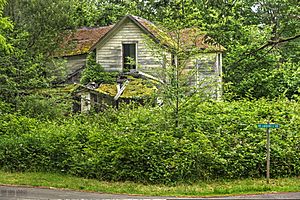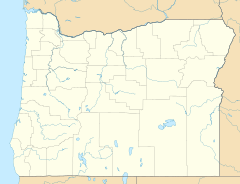Latourell, Oregon facts for kids
Quick facts for kids
Latourell
|
|
|---|---|

Old Latourell House, 2016
|
|
| Country | United States |
| State | Oregon |
| County | Multnomah |
| Elevation | 72 ft (22 m) |
| Population
(2020)
|
|
| • Total | 3,261 |
| Time zone | UTC-8 (Pacific (PST)) |
| • Summer (DST) | UTC-7 (PDT) |
| GNIS feature ID | 1167712 |
Latourell is a small, quiet place in Multnomah County, Oregon, United States. It's not a city, but an unincorporated community. You can find it along the Historic Columbia River Highway. It's about 13 kilometers (8 miles) east of Troutdale. It's also about 9 kilometers (5.5 miles) west of Multnomah Falls. In the 1880s, Latourell was a busy place. Today, it's almost like a ghost town.
Contents
History of Latourell
How Latourell Got Its Name
The town of Latourell and Latourell Falls are named after a man named Joseph "Frenchy" Latourell. He moved to Oregon in the 1850s. Joseph Latourell was a business owner. He had a store and a special machine called a fish wheel. He also worked as a boatman on the Columbia River.
Post Office and Railroad
The first post office in this area opened in May 1876. It was called Rooster Rock. This name came from a nearby natural rock formation. Joseph Latourell became the postmaster in August 1876. A year later, the post office name changed to Latourell Falls. This office stayed open until 1964. The local train station was simply called "Latourell."
Latourell Falls and Parks
The beautiful Latourell Falls are on land that used to belong to Guy W. Talbot. This area is now part of Guy W. Talbot State Park. There's also a place called Latourell Prairie. It's on the high ground above the river, east of the falls. This prairie is also named after Joseph Latourell.
Life in Early Latourell
The Latourell family had eight children. They were well-known to people from Portland. Visitors would come by steamboat to enjoy their company. The family was famous for singing, dancing, and playing musical instruments.
At its busiest, Latourell was a town focused on cutting timber. It had five places where people could gather. The town also had a very popular brass band. Large-scale logging started around the 1880s. Before that, many people living in the Columbia River Gorge would cut wood. They would then deliver this wood to the steamships on the Columbia River.



